

ALSEP was a collection of geophysical instruments
designed to
continue to monitor the environment of each Apollo landing site for a
period of at least a year after the astronauts had departed. Designed
for a life of one year (Apollo 17 was for two), they ended up working
for up to 8 years, the experiments permanently shut down by Mission
Control on 30 September 1977. Due to the experimental nature of the
first landing of Apollo 11, especially the mechanics of getting to the
lunar surface and back, science took a lesser role, so Apollo 11 had a
simpler version known as the Early Apollo Surface Experiments Package
(EASEP), with only two experiments.
The ALSEP/EASEP packages were stowed in
Scientific
Equipment Bay
(SEQ Bay)/Quad II during the flight from Earth.
The height of the pallets was at the
limit for easy manual deployment on level terrain. There were booms to
help with off-loading, particularly if the Lumar Module was tilted in
such a way that the Bay was higher than normal. Lanyards were
used to
release the packages and allow them to swing free and then be lowered
by pulley to the surface. On Apollo 15, the LM tilt put the package in
easy reach and the off-loading was done entirely by hand. The
pulleys were removed for A-17 since the
crew felt they weren't needed. The mission
timelines show offloading as a coordinated activity and allowed 8 to 9
minutes for both crewmen.
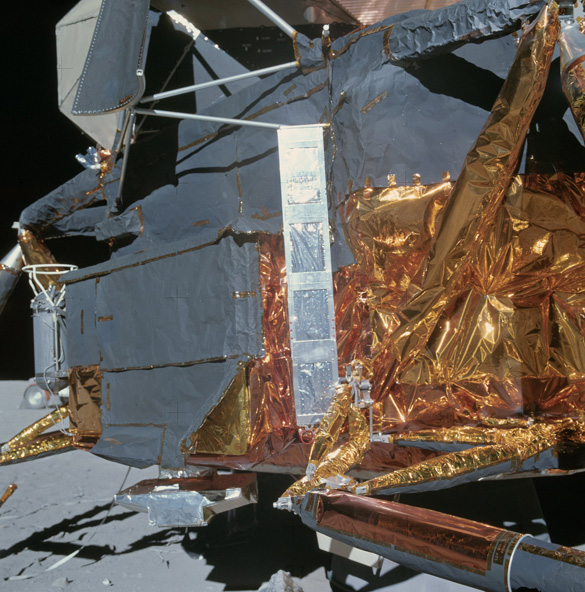
Photo AS16-113-18335 shows the dark grey doors of the Scientific Equipment (SEQ) Bay to the left of center, with a silver-colored, cosmic ray detector panel to the right of the doors and the protective cask for the RTG plutonium fuel element beyound the doors on the far left. A lanyard was used to pull the main door up and out of the way, revealing side doors which could be opened by hand.
Alan Bean has just offloaded Apollo 12 ALSEP package No. 2 from the SEQ Bay using a retractable boom, pulleys, and cables. Cooling fins on the RTG can be seen just to the right of Alan's right knee. Photo AS12-46-6783.
A level site for the ALSEP station was desired.
Generally, 100 meters
to the west of the Lunar Module (but not in its shadow at sunrise) was
seen as adequate. Craters and slopes were to be avoided since they
would degrade the thermal control of the unit. Apollo 14 had some
trouble finding such a site. Also, the location had to be far enough
away from the Lunar Module to avoid the dust and debris of ascent and
the seismic disturbance of the venting propellant tanks and thermally
creaking structure was desired. Add to this the need for a reasonable
straight and level area for a geophone line (on those missions with ASE
[Active Seismic Experiment] or LSPE [Lunar Seismic Profiling
Experiment]) and a clear area for mortar firings (for ASE). A
perfect site was difficult to find. The central station and most, if
not all, of the individual experiments needed to be levelled to within
5º of vertical and oriented with respect to the Sun. The
central
station was aligned within 5º of the E-W line using the
partial compass
rose and its gnomon. This was for proper thermal control.
The ALSEP was packaged on two major sub-pallets
in the Lunar Module,
which were removed and then attached to a "barbell" (which later became
the antenna mast) to enable hand carrying to the selected site. The
total mass of the ALSEP on Apollo 17, for example, was 163 kilograms on
Earth, or 27 kilograms on the Moon.
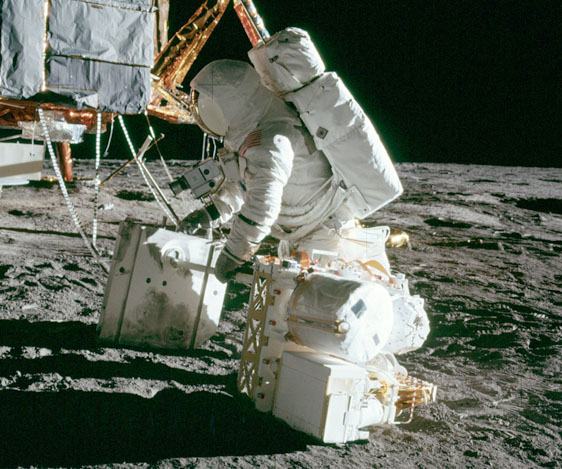
Alan Bean attaches ALSEP package No. 2 to the carry bar, which will later serve as the antenna mast. Package No. 1 is in the foreground, already attached to the carry bar. On package No. 1, the LSM, with its distinctive gold-colored arms, is nearest the ground; the Passive Seismic Experiment (PSE) is above the LSM at the upper left; and the Solar Wind Spectrometer (SWS) is above the LSM at the upper right. Photo AS12-46-6791.
The Apollo 12 crew was the first to deploy a full
ALSEP array and experienced a few problems carrying the packages out to
the deployment site. For example, the whole pallet tended to
rotate, especially the pallet containing
the RTG power supply. The crew commented that the necessity to grip the
carry bar tightly was tiring to the hands. On Apollo 14, Mitchell
commented that the bouncing sub-pallets at the end of the barbell made
it very difficult to carry and that he ended up carrying it across his
arms. It seemed considerably heavier than he anticipated since the
1/6th g
lightweight mock-up didn't respond in the same way. On Apollo 15, Irwin
decided to carry it in the crook of his elbow and had an easy time
carrying it to the deployment site. When the Lunar Rover was available
from Apollo 15, the Lunar Module Pilot still carried the ALSEP on foot,
while the Commander drove to the site.
Once the ALSEPs were established on the Moon,
tracking the signals was
shared around the Manned Space Flight Network, (from 1972 Satellite and
Tracking Data Network). It was monotonous work, as it was only tracking
the Moon and collecting and recording a steady stream of data of 9
million measurements per ALSEP per day. With 5 ALSEPs this swamped the
scientists with 45 million measurements per day.
...............................................................................
The ALSEP program began on March 31 1963 with a
series of meetings
between NASA Headquarters, the Jet Propulsion Laboratory (JPL), and the
Goddard Space Flight Center (GSFC). The first choice of experiments was
proposed in December 1963, and consideration was given to those
experiments that promised maximum return for least weight and
complexity. Suggested experiments were active and passive seismic
devices, instruments to measure the surface bearing strength, magnetic
field, radiation spectrum, soil density, and gravitational field.
During July 1965, the National Academy of
Sciences Space Science
Board met at Woods Hole, Massachusetts, to consider the most desirable
areas of space study. The board proposed 15 major items for lunar
exploration. Some of them were:
From the list of questions from the Woods Hole
meeting, it was
decided it was possible to design a complete lunar geophysical station,
which would give this information. It could be housed in a storage bay
of the Lunar Module and be deployed on the surface of the Moon by the
astronauts.
By June 7 1965 Dr George Mueller, the Associate Administrator for Manned Space Flight, authorised a budget for ALSEP, and responsibility of the management was assigned to the Manned Spacecraft Center's Experiments Program Office.
With a budget now available, the MSC Office had prototypes built by three firms: Bendix Systems Division, TRW Systems Group, and Space-General Corporation, each given a $500,000, six-month contract. The MSC Office would select one of the three to develop the final ALSEP flight hardware.
On February 14 1966 Homer E. Newall, advised the
MSC Office that he
had assigned the experiments to specific missions, and the institutions
and principal investigators would be:
On March 16 1966 NASA Administrator James E. Webb
and Deputy
Administrator Robert C. Seamans, selected Bendix Systems Division,
Bendix Corporation, to design, manufacture, test, and provide
operational support of the ALSEP packages, with the first delivery
scheduled for July 1967. The contract was approved by NASA on November
5 1966. The estimated cost of the cost-plus-incentive-fee contract
negotiated with Bendix before the presentation by the Source Evaluation
Board to Webb and Seamans, was $17.3 million.
Due to Apollo 11 being more of a test flight than
a scientific
mission, a simplified package was chosen. The Early Apollo Surface
Experiments Package (EASEP) was approved to be supplied by Bendix on
November 5 1966 for Apollo 11. Two experiments not formally part
of the EASEP were also flown.
The EASEP station, located 20 meters South of the
LM at 0.6735ºN
latitude 23.4730ºE longitude, was turned on at 0440 UT
July
21 1969 and failed on August 27 1969, 31 days beyond its designed
lifetime.
EASEP consisted of only two experiments:
Apollo 11
This instrument contained four seismometers powered by two panels of solar cells, which converted solar energy into electricity. It used three long-period seismometers and one short- period vertical seismometer for measuring meteorite impacts and moonquakes, recording about 100 to 200 hits by meteorites during its lifetime. Data regarding the strength, duration, and approximate direction of the seismic event were relayed to tracking stations on Earth. Because it was only powered by solar cells, the experiment only operated during the lunar days. During the 340 hour lunar night, when temperatures can plummet to minus 170ºC the instrument was kept to a minimum of minus 54ºC by a radioisotope heater, the first major use of nuclear energy in a NASA manned mission. Any temperature below this could damage the instrument.
At the other end of
the scale the scientists
tried controlling the
daytime heat on the electronic components by a series of power 'dumps',
cutting off the systems electrical power. Then, just before the lunar
night began, the seismometer automatically shifted into stand-by mode,
stopping transmission of all data. The seismic instrument package
stopped responding to commands at 0400 UT August 25 1969, probably from
overheating from the hot midday sun. An alternate design was
flown on later missions.
Apollo 11
This experiment
measured the amount of dust
accumulating on the
lunar surface. It also measured the damage to solar cells by
high-energy radiation as well as the reflected infrared energy and
temperatures of the lunar surface. It consisted of three photocells
mounted on the EASEP.
Apollo 11, 14, 15
This passive experiment consisted of an array of 100 fused silica cubes on Apollo 11, arranged to reflect a beam of light back on a parallel path to its origin. The LRRR placed on the Moon was aligned precisely so that it faced the Earth. Scientists from around the world directed laser beams at the instrument which reflected them back to Earth; the elapsed time for the round trip allowed precise measurements of distances, down to an accuracy of 8 centimeters, between the Earth and the Moon. This instrument continued operating until June 1981.
Apart from accurately determining the Moon's distance from the Earth, results have shown there is considerable warping of the lunar surface as it journeys around the Earth.
These reflectors were also deployed on the Apollo 14 and 15 missions. The Apollo 15 reflector had 300 silica cubes.
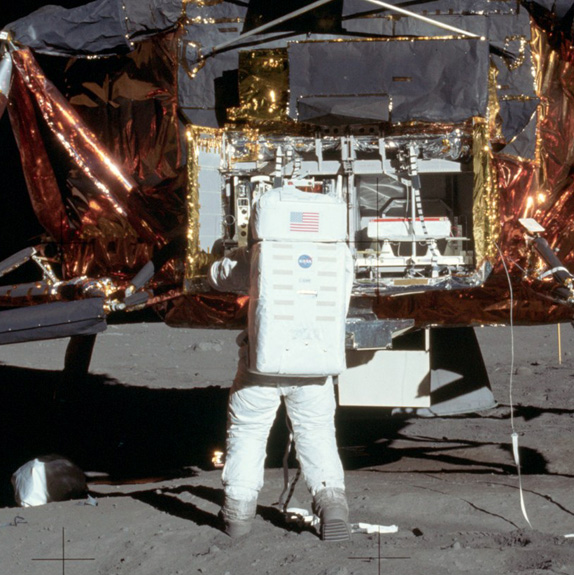
A detail from photo AS11-40-5927 shows Buzz off-loading the Passive Seismometer package from the lefthand SEQ Bay compartment. The laser reflector is in the righthand compartment.
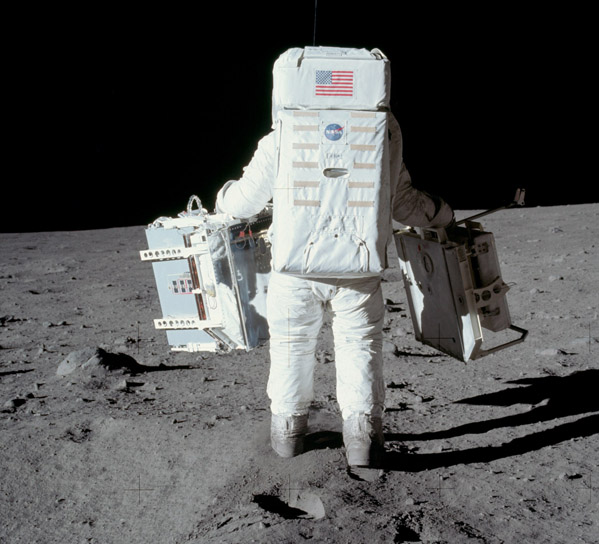
Buzz Aldrin carries the laser reflector in his right hand and the seismometer in his left.
Photo AS11-40-5942.
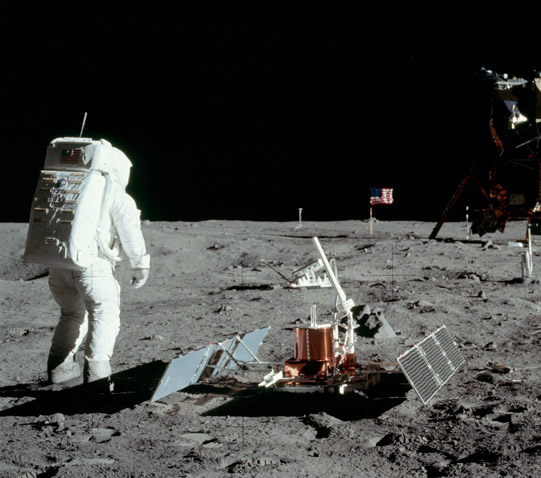
Buzz with the seismic experiment. Solar panels have deployed on the left and right and the antenna is pointed at Earth. The laser reflector is beyond the antenna and, in the distance, the TV camera is silhouetted against the black sky. The stereo close-up camera is near the righthand edge of this detail. Photo AS11-40-5948.
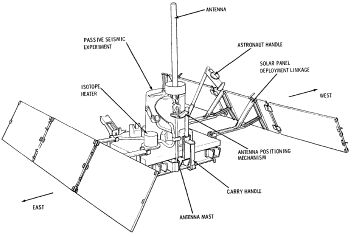
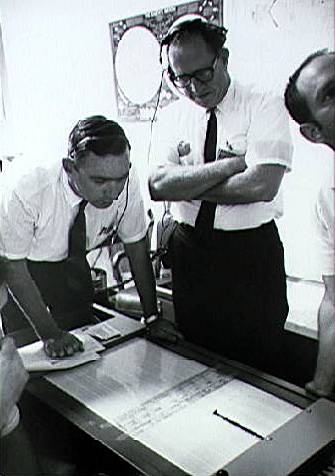
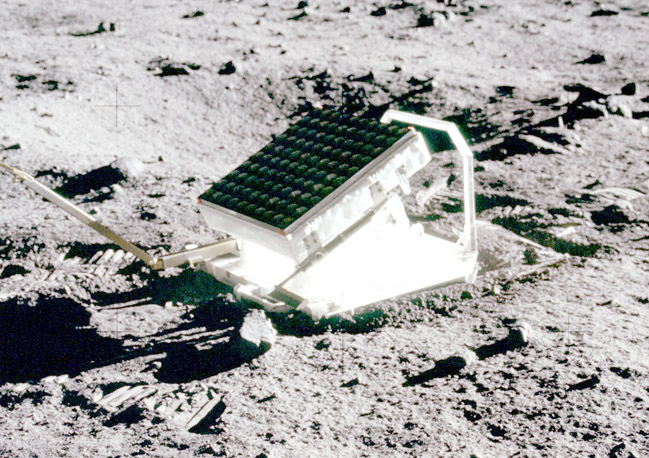
Enhanced detail of the Laser Ranging Retro-Reflector (LRRR).
Photo AS11-40-5952.
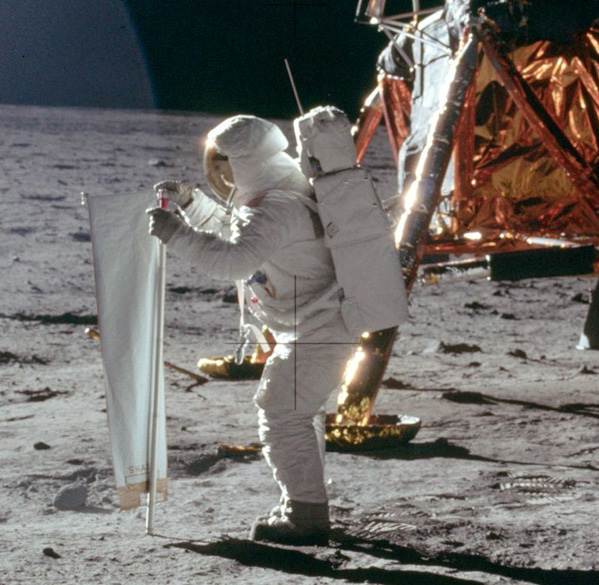
This detail from AS11-40-5872 shows Buzz deploying the SWC. He is orienting the foil sheet so that the side marked "SUN" - and not the side marked "SHADE" - is facing the Sun.
The ALSEP system, first flown on the Apollo 12 mission, consisted of a Central Station with an communications package and with leads running out to the instruments placed around it. DC power of 70 watts at 16 volts was supplied by a SNAP-27 model radioisotope thermo-electric generator (RTG), placed beside the station and connected to it by cables. A radioactive, plutonium fuel element for the generator was carried to the Moon in a protective cask mounted on the side of the Lunar Module, and was removed and inserted in the generator by the astronauts after they offloaded the generator and placed it on the ground. The power required by the whole station and experiments was less than the power of a 75-watt light bulb.
The station and instruments had to be deployed at
a distance of at
least 90 meters west from the LM to minimise disturbance from the LM
lift-off. ALSEP deployment, power-up, and activation was planned to
take a maximum of 120 minutes. The instruments were arrayed around the
central station, which supplied power to run the instruments and
provided two-way communications so data collected by the experiments
could be relayed to Earth and commands could be received. The central
station was a 25-kilogram box with thermal control achieved by passive
elements (insulation, reflectors, thermal coatings) as well as power
dissipation resistors and heaters. Communications with Earth was with
transmitters, receivers, data processors and multiplexers housed within
the central station, with signals transmitted through a 58 centimeter
by 3.8 centimeter modified axial-helical antenna mounted on top, and
pointed towards Earth by the astronauts. Data collected from the
instruments was converted into a telemetry format and transmitted to
Earth. The ALSEP systems and instruments were controlled by commands
from Earth, sent through the tracking stations.
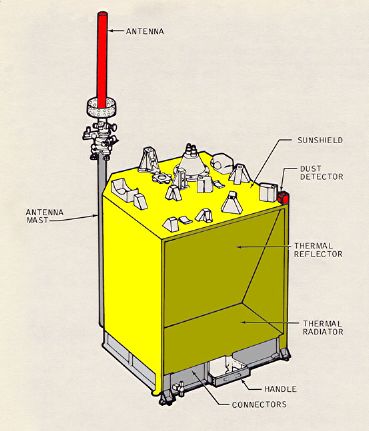
The ALSEP Central Station formed the base of Package No. 1 and, on the top in this diagram, we see various pieces of hardware where experiments were attached prior to removal and deployment. The antenna mast served as the carrybar when the LMP brought the packages out to the deployment site. On top of the antenna mast are a set of gimbals used to point the antenna at Earth. Ribbon cables from the various experiments were attached at the bottom of the side facing us in this view. The thermal radiator and thermal reflector kept the Central Station electronics in the base from overheating.
Artist's concept of the Apollo 15 ALSEP layout. The relative positions of the instrument are as planned and close to the deployed configuration. A larger version is linked here.
The uplink frequency for all Apollo ALSEP's was 2119.0 MHz.
The down link frequencies were:
An unexpected problem with the first ALSEP on Apollo 12 involved the cables that connected the various experiment modules to the Central Station. Although the cables were fairly stiff, on Earth they tended to lie flat to the ground, held down by their own weight. However, on the Moon, the cables hardly seemed to notice the one sixth gravity and retained loops and bends they had acquired during storage inside the LM - loops that stood up from the ground rather like sections of a frozen garden hose. There were no disastrous tripping episodes during Apollo 12 such as occurred on Apollo 16, but the need to dodge cable loops slowed the astronaut's work.
ALSEP experiments varied from mission to mission but each mission contained selections of the following experiments:
To determine sub-surface properties and measure
extremely small
vibrations of the lunar surface caused by distant moonquakes, man-made
explosions, and spacecraft impacts. When the instrument vibrated in
response to movement of the ground surface, the inertia of the central
lever and the mass on
the end caused it to vibrate in sympathy, which was detected
electronically by the capacitor effect of the mass on the end of the
lever. An internal set of motors kept the seismometers constantly level
within a few seconds of arc. Seismic motions were recorded on Earth
with a magnification factor of 10 million. The network of four
instruments deployed during Apollo enabled the seismologists to locate
moonquakes
in three dimensions, and to study the seismic velocities and
propagation characteristics of the lunar subsurface materials. The PSEs
measured daily meteorite impacts and an average of two
moonquakes per month, up to depths of 800 kilometers. Earthquakes on
the Earth exceed one million per year. On the Moon, there may be up to
300. And they are much smaller than the ones on Earth. It was noted
that there was increased activity when the Moon was farthest from, and
nearest to, the Earth. Signals generated by heating at sunrise on
the Moon's surface was recorded by ALSEP each lunar day.
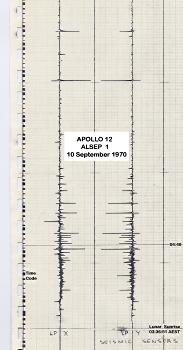
Plot of seismic activity generated by heating of the lunar surface at sunrise. From the collection of HSK Technician Laurie Turner. A larger version is also available.
The Passive Seismic Experiment studied the
propagation of seismic
waves through the Moon and provided our most detailed look at the
Moon's internal structure. The Apollo 11 seismometer returned data for
just three weeks but provided a useful first look at lunar seismology.
More advanced seismometers were deployed at the Apollo 12, 14, 15, and
16 landing sites and transmitted data to Earth until September 1977.
Each of these seismometers measured all three components of ground
displacement (up-down, north-south, and east-west).
If a seismic event is observed by three or more
seismometers
separated by distance, the time and location of the event can be
determined. Because seismic waves from distant events travel deeper
into the Moon than waves from nearby events, by measuring events at
various distances from the seismometer, one can determine how seismic
velocities vary with depth in the Moon. In turn, this information can
be used to study the Moon's internal structure. Most of the events
observed by the seismometers were due either to moonquakes or to
meteoroid impacts. However, the third stages of several Saturn 5
rockets and the ascent stages of several lunar modules were
deliberately crashed onto the Moon after they were discarded. These
man-made crashes produced seismic events of known times and locations
and helped to calibrate the network of seismometers.
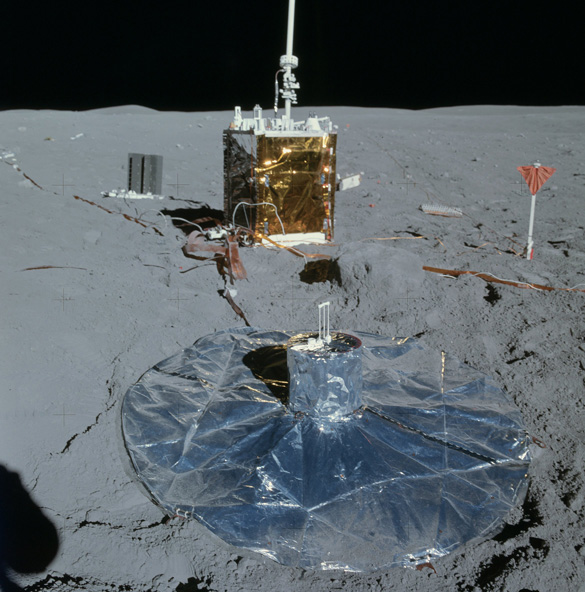
The Apollo 16 PSE is in the foreground, surrounded by its reflective thermal skirt. An orange-topped anchor for the Active Seismic Experiment geophone line is on the right, near the Central Station. Photo AS16-113-18347.
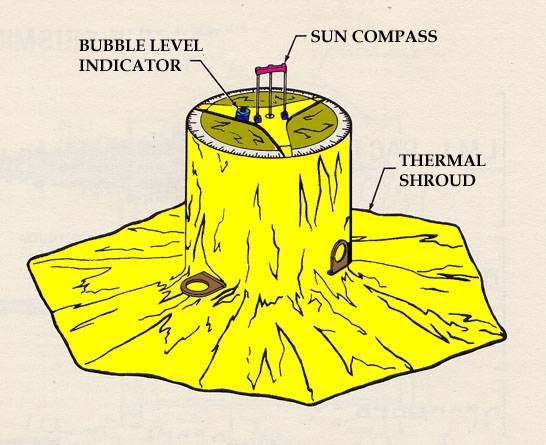
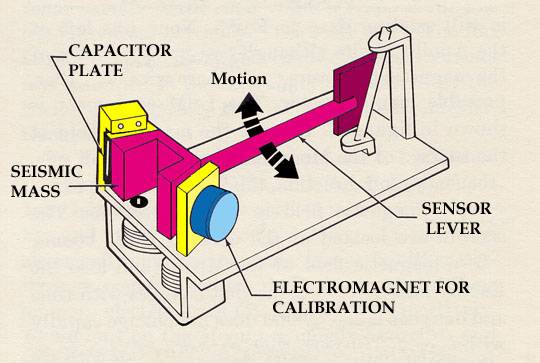
The Passive Seismic Experiment produced several
important scientific
results:
Knowledge of Lunar Interior Structure. Like the Earth, the Moon has a crust, mantle, and core. The lunar crust is rich in the mineral plagioclase and has an average crustal thickness of 50 kilometers. The lunar mantle lies between the crust and the core and consists mostly of the minerals olivine and pyroxene. The core is probably composed mostly of iron and sulphur and extends from the center of the Moon out to a radius of no more than 450 kilometers, i.e., the core radius is less than 25% of the Moon's radius, which is quite small. In comparison, the Earth's core radius is 54% of the Earth's radius. However, the size of the lunar core is not well constrained by existing seismic observations. Better constraints came from the laser ranging retro-reflector and magnetometer experiments.
Distribution of Lunar Seismic Sources. More than 1,700 meteoroid impacts were recorded by the seismometer network, with impactor masses estimated to be between 0.5 and 5000 kilograms. Most moonquakes occur at depths of 800 to 1000 kilometers. These occur at monthly intervals at about 100 distinct sites, indicating that these moonquakes are caused by stresses from changes in lunar tides as the Moon orbits the Earth. These moonquakes are quite small, mostly with Richter scale magnitudes less than 2. The amount of energy released by earthquakes in a typical year is about 10 million times larger than that released by moonquakes in a year. Only a few near-surface moonquakes were detected.
Attenuation of Seismic Waves. Meteoroid impacts cause heavy fracturing in the upper 20 kilometers of the lunar crust. These fractures in turn cause scattering of seismic waves in these regions. Below 20 kilometers, seismic wave scattering decreases as a result of either closure of these fractures due to increasing pressure, or of a change in chemical composition of the crust. In the mantle, seismic waves are attenuated much less on the Moon than they are on Earth. Seismic wave attenuation is enhanced at high temperatures and in the presence of water, and the low attenuation on the Moon indicates a cold, dry interior. Because the Moon is smaller than Earth, it is expected to have cooled more rapidly, producing a cold interior. The total absence of water on the Moon is due to its formation from dry volatile-depleted material, a consequence of the impact of a Mars-sized body with the Earth. Below 1000 kilometers depth, seismic wave attenuation increases, possibly indicating the presence of a small amount of molten rock.
Scientists hoped that moonquakes and meteorite
impacts would answer two fundamental questions: (1) does the Moon have
a molten core; and
(2) what is the deep interior of the Moon like? To answer these
questions
they needed at least one impact event of at least 1019
ergs on the far side of the Moon. On May 13 1972 a near-side event with
an
energy of 1,100 kilograms was recorded. On September 19 1973 a
large back-side event with an energy of 1018 ergs took
place. On July 17 1972, only three months after it was set up, Apollo
16’s seismometer registered the largest impact ever recorded on the
moon when a meteorite hit the far side of the moon near Mare
Moscoviense, located at 26ºN 147ºE.
Over the 8 years of the ALSEP’s lives, around
10,000 moonquakes and 2,000 meteorite impacts were registered by the
seismometers.
The seismic information, magnetometer, and heat
flow experiments contributed the principal information about the Moon’s
interior. It is now believed the Moon’s crust is multi-layered and 50
kilometers thick, with a secondary boundary occurring about 20
kilometers under the surface. The upper mantle has been determined to
consist of olivine or olivine-pyroxene matter, and to be quite
homogeneous, extending about 500 kilometers down. Below this level the
seismic data infers the interior is iron-enriched, although there is
insufficient data to determine if the Moon has a molten core.
Moonquakes were discovered to show periodicity
and recur at several places in the interior. The time cycle of the deep
focus moonquakes follows the tidal cycles so closely it appears likely
that tidal forces are a major factor in triggering deep focus
moonquakes.
The first man-made crash directed at the Moon that could be detected by a seismometer occurred after the Apollo 12 astronauts had returned to the CSM and the LM ascent stage was sent smashing into the Moon's surface. The shock waves of this impact surprised the scientists - the Moon vibrated for over 55 minutes!! Also, the kinds of signals recorded by the seismometers were utterly different from any ever received before, starting with small waves, gaining in size to a peak, and then lasting for incredibly long periods of time. A seismic wave took 7 to 8 minutes to reach the peak of impact energy and then gradually decreased in amplitude over a period that lasted almost an hour. It was claimed that even after an hour the minutest reverberations had still not stopped.
When the Apollo 12 LM hit the lunar surface at 6,048 kilometers per
hour, 72 kilometers from the landing site, digging an estimated 9 meter
wide crater, the results were astonishing. All 3 seismometers in the
package recorded the impact, which set up a sequence of reverberations
lasting nearly an hour. Nothing like this had ever been measured on
Earth.
The LM impact occurred at 1617 USCST November 20 1969. A news
conference had been scheduled to begin at 1630, and when it did start,
the Moon was still "ringing" as the scientists - all of
them seismic experts - arrived at the news center from
their laboratories.
Maurice Ewing, co-head of the seismic experiment, told the afternoon
crowd of the unexpected event, informing them that the Moon was still
ringing. He confessed he was at a loss to explain why the Moon behaved
so strangely. "As for the meaning of it," Ewing announced, "I'd rather
not make an interpretation right now. But it is as though one had
struck a bell, say, in the belfry of a church a single blow and found
that the reverberation from it continued for 30 minutes." As he spoke
the reverberations continued on for another 25 minutes.

Seismometer trace from the Apollo 12 PSE
produced by the purposeful impact of the Apollo 12 LM ascent stage.
The Active Seismic Experiment was complementary
to the Passive Seismic Experiment in two ways, scale and source of
energy. The Passive Experiment was designed to study the whole Moon;
the Active Experiment to study the local area. Rather than wait
passively for natural events to occur on the Moon to produce shock
waves, the Active Experiment provided its own sources. The shock waves
are produced by explosions on the lunar surface. Two different kinds
are used, small ones made while the astronauts are on the surface and
large ones after they left the site and returned to the Earth.
The different kinds of sources for the Active
Experiment were a "thumper" and a "mortar." The thumper was used
by the astronaut to explode ''shotgun-like'' charges. The thumper
contained 19 such charges. It was fired at evenly spaced intervals
along the geophone line. The results from this part of the experiment
were available while the astronauts were still on the surface of the
Moon.
The second kind of charge was similar to that of
a mortar. In fact, the unit that fired these charges was referred to as
a mortar package assembly. It contained four grenades that were
launched using self-contained rockets sometime after the astronauts had
left the Moon. The astronauts aligned the mortar launcher and armed it
for firing. This unit contained geophones for measuring the velocity of
each grenade on launch and the exact time of launch. Each grenade
contained a rocket motor, a high explosive charge, provisions for
igniting the rocket and a device to detonate the charge, a battery, a
transmitter that provided information as to the length of time of the
flight and the moment of impact on the Moon, and a thread with which to
measure the distance of the impact from the launcher. Because there is
no atmosphere on the Moon, the thin thread trailing the grenade
remained taut and measured accurately the horizontal distance from the
point of launch to the point of impact. They had been designed to
impact the Moon at distances of 137, 282, 853, 1372 meters from the
launcher. The size of the explosive charge increased with distance. Any
layering in the Moon that is present in the first 300 meters beneath
the surface would be seen with the Active Experiment.
Two experiments, the Active Seismic Experiment on Apollo 14 and 16 and the Lunar Seismic Profiling Experiment on Apollo 17, were performed to determine the detailed structure of the upper kilometer of the lunar crust. Both experiments involved detonation of a series of small explosives. The seismic waves, or ground vibrations, caused by these explosions were measured by a network of geophones (a kind of electronic stethoscope). On Apollo 14 and 16, up to 19 small explosions were detonated by an astronaut using a device called a "thumper" along a 90-meter-long geophone line. On Apollo 16, three mortar shells were also used to lob explosive charges to distances of up to 1,300 meters from the ALSEP.
Both the Apollo 16 mortar shells and the Apollo 17 explosives were detonated by radio control after the astronauts left the lunar surface.
These experiments showed that the lunar seismic
velocity is between 0.1 and 0.3 kilometers per second in the upper few
hundred meters of the crust at all three landing sites, which agrees
closely with the passive data. These velocities are much lower than
observed for intact rock on Earth, but are consistent with a highly
fractured or brecciated material produced by the prolonged meteoritic
bombardment of the Moon. At the Apollo 14 site there was a regolith
surface layer of 8.5 meters. At the Apollo 17 landing site, the surface
basalt layer was determined to have a thickness of 1.4 kilometers,
slightly higher than the 1 kilometer thickness determined from the
Traverse Gravimeter Experiment.
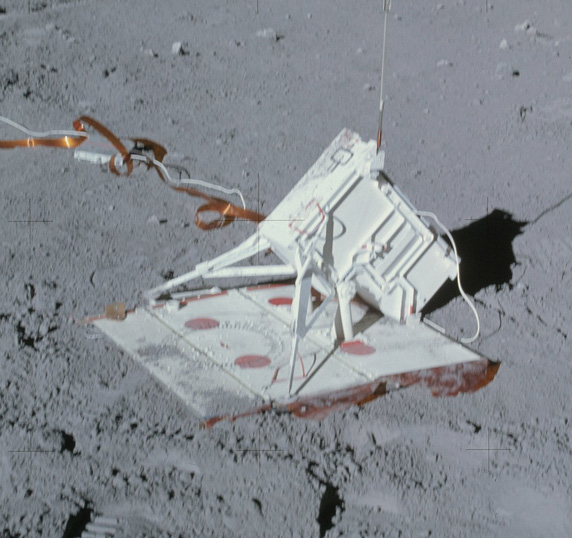
This detail from AS16-113-18378 shows the Apollo 16 mortar package mounted on its base.
The ribbon cable running off to the left connects the experiment to the Central Station.
The mast sticking upwards has a red-warning flag at the top
so that the crew could stay well clear when driving the Rover.
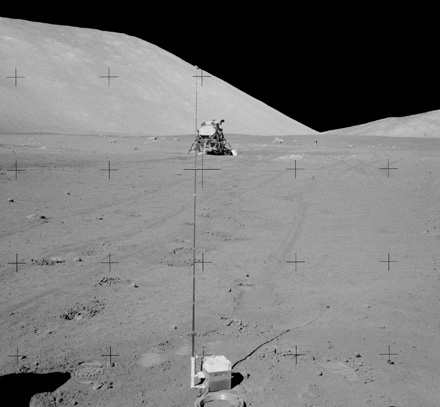
This detail from AS17-143-21936 shows Apollo 17 Seismic Charge No. 3, which Gene Cernan deployed 110 meters WNW of the LM late in EVA-3. The charge antenna received a command, sent from Earth through the ALSEP Central Station, to detonate the 57-gram charge at 0307 GMT on 18 December 1972, at which time the crew was about halfway back to Earth. The aluminum ring next to the charge marks the end of the west arm of the SEP transmitter array and is 35 meters west of the SEP transmitter.
Heat flows from hot regions to cooler regions. The interior of the Moon is warm compared to the surface, therefore heat flows from the interior to the surface where it is lost into space by radiation. This heat is mainly produced by the decay of natural radioactive elements thorium, uranium, and potassium, raising the heat of the interior of the Moon. The Heat Flow experiment was designed to measure the heat loss from the interior of the Moon.
The results of the Heat Flow Experiment were used to set the limits on the amount of radioactivity - the long-term source of internal heating of the Moon - and to set limits on models of the thermal history of the Moon. The rate at which a planet loses its internal heat to space is an important control on the level of tectonism (faulting and folding of the planet's surface due to internal deformation) and volcanic activity on the planet. This loss of internal heat was measured by the Heat Flow Experiments on Apollo 15 and 17. This experiment was also attempted on Apollo 16, but failed due to a broken cable connection.
The HFE involved drilling two holes into the regolith to depths of 1.6 to 2.3 meters. The second hole and measurement was to confirm the readings from the first hole. The temperature was measured at several depths within each hole by platinum resistance thermometers placed at several points in the lower parts of the holes and several thermocouples placed in the upper part of the holes. The rate at which temperature increases with depth is a measure of the heat flowing from the Moon's interior. The drilling caused some heating within the hole, although the effects of this heating decayed with time. Also, temperatures in the upper part of the regolith vary as the amount of incident sunlight changes throughout the lunar day and night. By monitoring temperatures in the drill holes over a long period of time, these effects can be accounted for, allowing a determination of the average heat flow rate at the landing site.
The HFE found that the surface layer temperature
during the night was 76ºK (-197ºC) rising to a maximum of
358ºK (+85ºC) during the day. The temperature at 1.5 meters
under the surface was a constant 253ºK (-20ºC), indicating
the regolith is an excellent thermal insulator. The results of
these measurements indicate a heat flow of 21 milliwatts per square
meter at the Apollo 15 landing site and of 16 milliwatts per square
meter at the Apollo 17 landing site. The Earth's average heat flux is
87 milliwatts per square meter. The small value of the lunar heat flow
was expected, given the Moon's small size and the observation that it
has been nearly dead volcanically for the last 3 billion years. Because
the heat flow was measured at only two locations, it is not known how
representative these values are for the Moon as a whole. However,
because both measurements were obtained near boundaries between mare
and highland regions, it is thought that the measured heat flows are
probably 10-20% higher than the average value for the entire Moon.
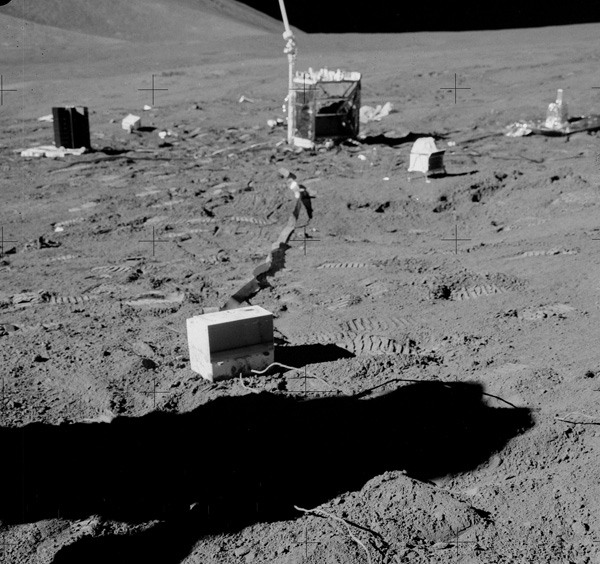
In this detail from photo AS15-92-12416, the HFE electronics package is in the foreground with a wide, ribbon cable running back to the Central Station and two thinner cable in the foreground connected to the heatflow probes that were inserted into two holes drilled for the experiment.
Only one of the two Apollo 15 heatflow probes was successfuly emplaced to full depth. There was evidently an obstruction in the drill string in Hole No. 2, believed to be due to separation of two stems that occurred when the astronauts tried to overcome binding of the stems in the hole. A re-design of the stem joins eliminated the problem of binding on Apollo 16 and 17. Unfortunately, no data was returned from Apollo 16 after the HFE ribbon cable was accidentally sheared off at the base of the Central Station. Good data was obtained from the Apollo 17 emplacement, which confirmed the Apollo 15 results.
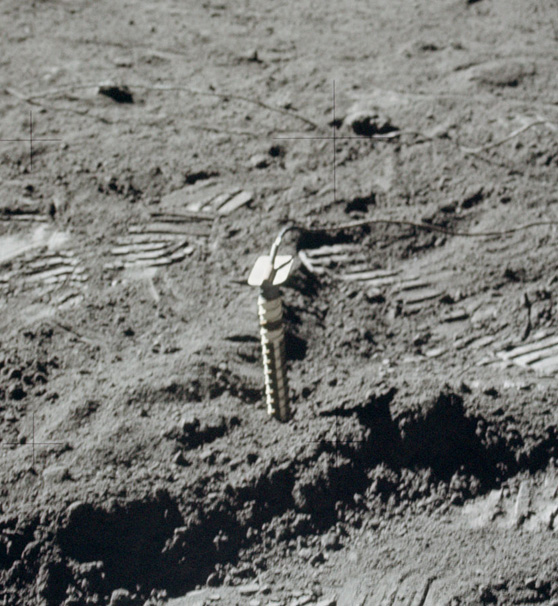
This detail from AS17-134-20493 shows one of the two holes drilled for the Apollo 17 HFE. The holes were drilled using hollow drill stems, with a closed bit on the bottom stem to keep the string open. Once a hole was drilled to the desired depth, a multi-sensor probe was inserted and a thermal cap emplaced around the cable that connected the probe to the HFE electronics package.
A tri-axis fluxgate magnetometer measured the
variations of the magnetic field of the Moon with time. Because the
magnetic field of the Moon can change in amplitude, frequency, and
direction, the magnetometer measures the field in three directions with
sensors located on the end of three small booms. The electronics were
contained in a box at the base of the three booms. It could measure
magnetic flux in nanoTeslas (nT) in three ranges with a resolution of
0.2 nT:
Magnetic fields of the Earth and Moon have two
parts; one that changes with time, and one that is steady. The part
that changes with time is caused by travelling electromagnetic waves.
The steady part of the Earth’s magnetic field, which affects the common
compass, varies from 35,000nT at the equator to 60,000nT at the poles,
whereas the lunar magnetic field is only about 6 to 100 nT gamma, most
likely due to the presence of natural magnetism in lunar rocks
inherited early in the Moon’s history, when the magnetic field was much
stronger that it is today. The Lunar Orbiters data inferred there was a
steady magnetic field of about 8 nT. The magnetometer also measured the
variation in time of the magnetic field, caused by electromagnetic
waves propagated from the Sun.
The moon has no global magnetic field like the Earth because it no longer has an internal dynamo, so it was a surprise when magnetometers placed by Apollo astronauts on the surface detected a faint magnetic field, as large as hundreds of nanoteslas. When the scientists built an electron detector that flew in lunar orbit aboard Apollo 15 in 1971 and Apollo 16 in 1972, they quickly realized they could use the instrument to remotely map the magnetic fields on the surface. Though crude and covering only about 10 percent of the lunar surface, the measurements nevertheless indicated a correlation between meteor impact basins -- dark, roughly circular features on the face of the moon and strong magnetic fields on the diametrically opposite side of the moon.
Theorists came up with an explanation for magnetic fields antipodal to impact basins not long after the Apollo measurements hinted at a correlation. When a large meteorite hits the moon, it and much of the local lunar surface is vaporized and thrown into space, forming a cloud of debris and gas larger than the moon itself. Because of the heat released in the collision, much of the gas is ionised plasma in which the atoms are stripped of one or more electrons.
Such plasmas exclude magnetic fields, so as the cloud spread around the moon it pushed the moon's magnetic field in front of it. When the plasma cloud finally converged on the diametrically opposite side of the moon -- a mere five minutes after impact -- the squeezed magnetic field would be quite large.
At the same time debris was falling back on the lunar surface, concentrated at the antipodal site also. If this debris dropped onto the surface during the time when the magnetic field was high, it could have undergone shock magnetization. When rock is shocked, as when hit with a hammer, it can suddenly lose its own magnetic field and acquire that of the surrounding region.
Scientists think that the magnetism of the Moon's surface is left over from a time when the Moon's magnetic field was actively created by a dynamo within the lunar core, and that this remnant magnetism may gradually erode away. Theories also suggest that the Moon's magnetism may come from collisions with other celestial bodies such as asteroids and comets, which might have imparted to the Moon some magnetic properties.
The LSM measured a steady 38 nanoteslas (nT) at
the Apollo 12
site, and 6 nT at the Apollo 15 site.
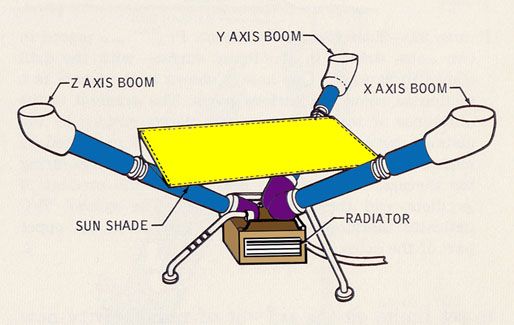
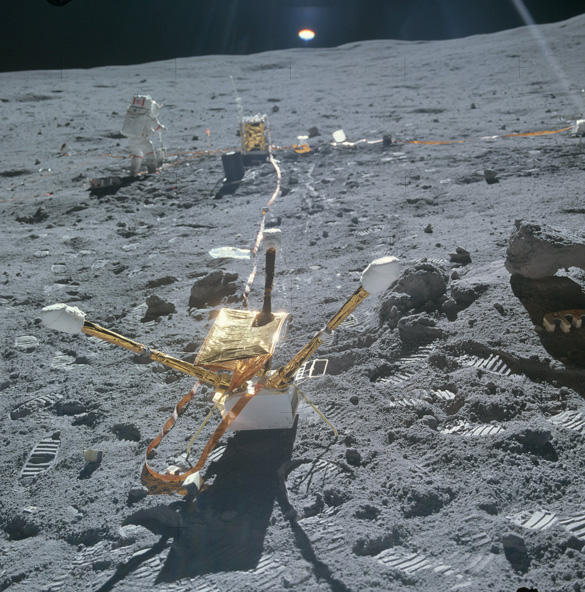
The fully-deployed Apollo 16 LSM is in the foreground,
with John Young working in the background near the Central Station.
Note the large boulder on the right. Photo AS16-113-18374.
This experiment measured the amount of dust accumulating on the lunar surface, which translated into the solar illumination detected by the cells. It also measured the damage to solar cells by high-energy radiation as well as the reflected infrared energy and temperatures of the lunar surface. It consisted of three photocells mounted on the Central Station.
Prior to the Apollo landings, it was thought that there would be a heavy dust layer deposited on the ALSEP experiment package during LM ascent and possibly from other long-term sources. This experiment was designed to measure this dust layer deposition and was performed on Apollo 11, 12, 14, and 15 missions. It was housed in the ALSEP central station and measured the power output and temperature of the three solar cells. The dust accumulation proved to be much lower than expected, and the results from this experiment were also used to monitor the long-term degradation of solar cells from radiation and thermal effects. This was considered to be an engineering rather than a scientific experiment.
The function of the experiment was to separate and measure high-energy radiation damage to the solar cells, to measure reduced solar cell output due to dust accumulation, and to measure reflected infrared energy and temperatures for use in computing lunar surface temperatures. The Dust Detector had two components -- a sensor package mounted to the top of the Central Station sun shield, and a printed circuit board located within the Central Station that interfaced with the power distribution unit of the ALSEP data subsystem.
The solar wind is composed of matter ejected continuously from the Sun that spreads throughout the Solar System. The energy, density, direction of travel, and its variations were measured by the SWS. Seven sensors were located under dust shields, allowing a study of the solar wind at the lunar surface, the general properties of the solar wind and its interaction with the Moon. The solar wind stretches the Earth’s magnetic field out behind the Earth, beyond the Moon’s orbit, so the SWS also studied the Earth’s magnetic tail when the Moon passed through it.
The Apollo 12 SWS surprised the scientists by continuing to send data after the Sun had set. Dr Conway Snyder of JPL said, "The spectrometer didn’t quit sending data – it continued to send back information on protons and even photo electrons several minutes after the Sun had stopped shining on it." He suspected the protons were sneaking around the edge of the Moon.
The SWS found the solar wind behaved the same as
in free space outside the Earth’s magnetic tail and is slightly
disturbed in the geomagnetic transition region. The surprise was the
detection of a gas cloud from the Apollo 13 Saturn-IV impact.
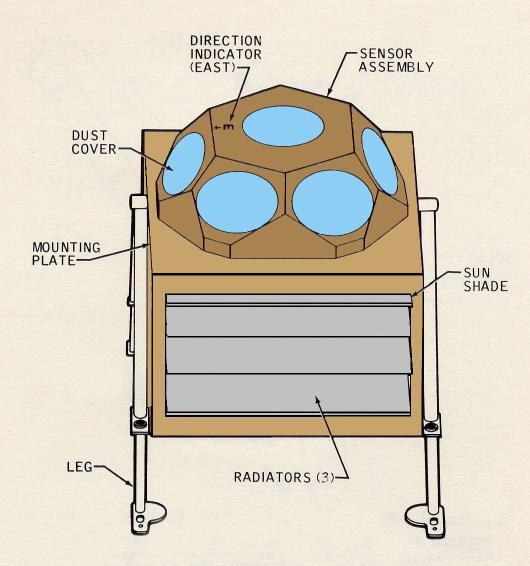
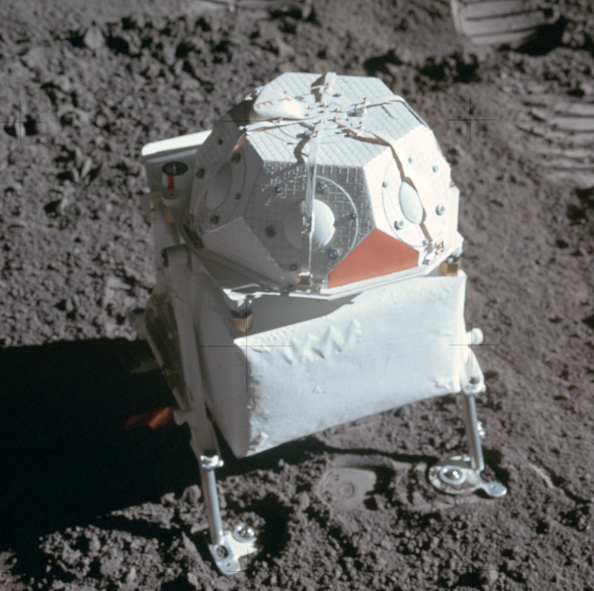
Two experiments, the Suprathermal Ion Detector
Experiment (SIDE)
and the Cold Cathode Ion Gauge (CCIG) were used to measure the number
and types of ions (an electrically charged molecule, either positive or
negative) on the Moon. These ions are chiefly hydrogen and helium and
are largely derived from the solar wind. The SIDE was used to measure
the flux, number, density, velocity, and relative energy of the
positive ions near the lunar surface.
The SIDE had sensors which were
directional, pointing in the ecliptic
plane 15 degrees from the lunar local meridian. Due to the range of
longitudes of the three mission landing sites, the look directions of
the instruments were about 38 degrees west, 2 degrees west, and 19
degrees east of the Earth for Apollo 12, 14, and 15, respectively. Thus
at certain times during the lunar orbit they could see ion flows in the
magnetosheath, but never looked directly at the solar wind. During
other times the detectors saw ion events of several different types;
some appear to be mainly related to the moon and others to the
magnetotail. These instruments resulted in numerous publications and
theses. The data had been used to determine the potential of the lunar
surface, to determine the effective plasma screening length at the
surface, to study the ion mass spectra, and to study magnetotail ion
fluxes.
On all three missions on which it was flown, the
CCIG was connected
to the SIDE by a short electrical cable. It was used to measure the
pressure of the lunar atmosphere. It operates at pressures of 10-6
to
10-12 torr. For a comparison the Earth’s atmosphere at
sea level is 760 torr. The pressure measured by the Apollo 14
CCIG on the lunar surface was 10-12 torr. It is interesting
to note the astronauts continually released gas molecules, mainly water
and carbon dioxide, from their space suits and this was happily
measured by the CCIG from astronauts in the immediate vicinity.
During the Apollo 12 deployment, set/memory
in the connecting cable
made it difficult for the astronauts to properly position the CCIG
while keeping the SIDE upright. As originally designed, the SIDE
was supported by three short legs. For Apollo 14, a
stabilizer was added as indicated in the figure above.
Unfortunately, Ed Mitchell had even more trouble getting the CCIG
properly positioned without disturbing the SIDE. A significant redesign
was done for Apollo 15.
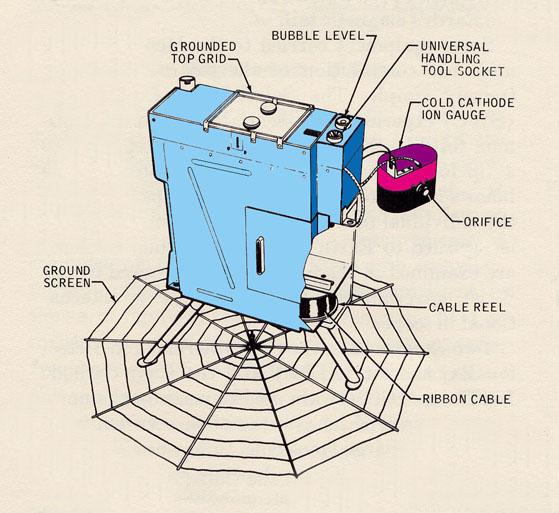
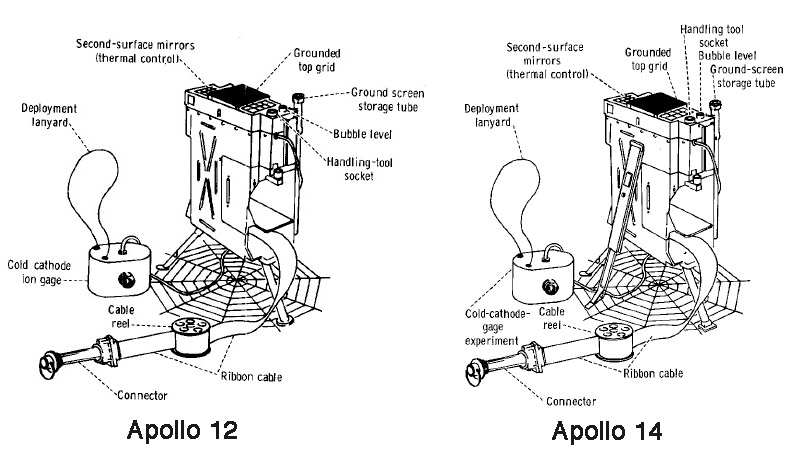
Apollo 12 (left) and Apollo 14 (right) SIDE and Cold Cathode Ion Gauge (CCIG).
The stablizer was added after the Apollo 12 crew had trouble with the deployment
due to stiffness in the cable connecting the experiments. The Apollo 14 crew had similar problems.
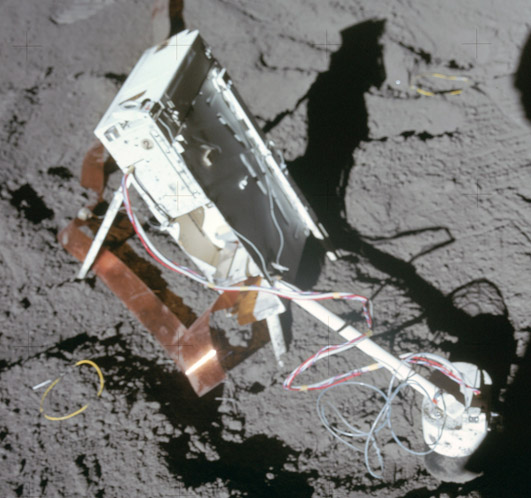
For Apollo 15, the SIDE was leaned back, with better support from two short legs on the bottom and a longer leg on what was now the back; and the CCIG was attached to the SIDE by a rigid boom that kept the combination from being disturbed by set/memory in the connecting cable. Photo AS15-86-11595.
Only used on one mission, this experiment measured the particle energies of solar protons and electrons that reach the lunar surface. It provided data on the energy distribution of these solar particles and their effect on the Earth/Moon system, as well as the relationship of the solar wind to Earth auroras; the Van Allen radiation belt; processes taking place at the shock front of the solar wind striking the lunar surface; characteristics of the earth’s magnetic field; and the effect of charged particles on the lunar environment.
It measured protons and electrons in the energy range of 40,000 to 70,000 electron volts (40 to 70 Kev) and consisted of 2 spectrometer packages oriented for minimum exposure to the Sun’s ecliptic path. Each spectrometer had 6 particle detectors – 5 C-shaped channeltron photon –multipliers consisting of glass capillary tubes of 1 millimeter diameter, 10 centimeters long; and 1 helical funneltron photon-multiplier with an 8 millimeter opening.
Particles of a given charge and different energies entering the spectrometer were subject to varying voltages and deflected toward the five photon-multipliers, while particles of the opposite charge were deflected to the funneltron photon-multiplier. Electrons and photons were thus measured simultaneously at five different energy levels. The CPLEE was deployed 3 meters north east
of Apollo 14’s central station. Results showed there are low
energy photo-electrons during the day, with large changes in the solar
wind flux. The unexpected was the detection of electrons with
terrestrial aurorae band energies in the Earth’s magnetospheric tail.
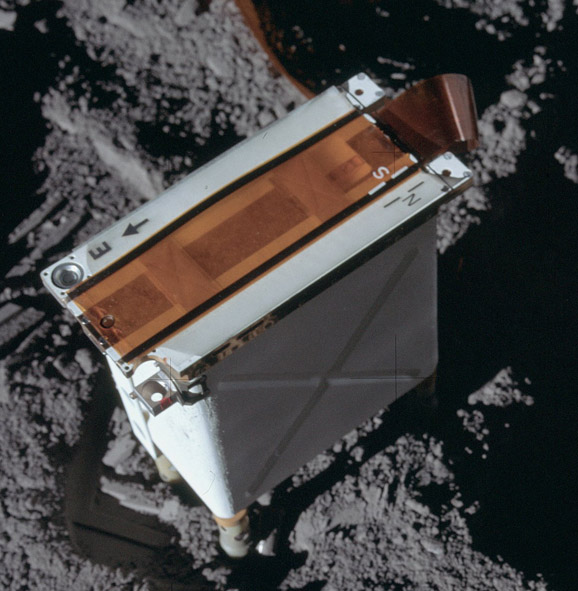
Only flown on Apollo 17 ALSEP, the LSG’s major
goal was to confirm the existence of gravity waves as predicted by
Einstein; to measure the response of the Moon to the Earth’s tidal
pull; and to detect free lunar oscillations in periods of 15 minutes or
longer. It could also measure vertical components of seismic events
with frequencies up to 16 cycles per second, thus supplementing the
passive seismic network of Apollo 12, 14, 15 and 16 missions.
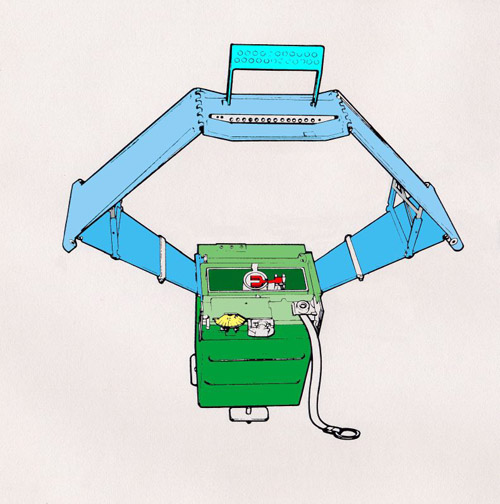
This instrument was designed to make very accurate (1 part in 1011) measurements of the lunar gravity and of its variation with time. It was essentially a sensitive spring balance, and also functioned as a one-axis seismometer. Its intent was to measure gravity waves by using the Moon as an antenna and also investigate tidal distortions of the shape of the Moon. Following deployment of the gravimeter during Apollo 17, problems occurred in trying to balance the beam. These problems were caused by a mathematical error in the sensor mass weights. Several reconfigurations of the instrument had been made during the previous year.
It was discovered on EVA 2 that the sensor beam of the LSG could not be nulled (using the micrometer screw adjustment of the instrument), even though Harrison Schmitt re-verified that the instrument was level and the gimbal was free. Later analysis showed a design (arithmetic) error of the sensor mass weights. They were approximately 2% lighter than the proper nominal weight for one sixth gravity operation of the flight unit. The sensor mechanism allowed up to only 1.5% adjustment from the nominal for possible inaccuracies. The error was made in the conversion calculations from 1 g to 1/6 g for the flight unit by including an erroneous value in the calculations from the uncorrected calculations for the qualification unit.
Repairs were attempted on EVA 2 and 3, but were
unsuccessful. Schmitt rapped the exposed top plate on the gimbal;
rocked the experiment in all directions; re-levelled the instrument,
working the base well against the surface; and verified the sunshade
tilt. These actions were taken to free a mass assembly or a sensor beam
that was suspected of being caught or bound, but no change was
apparent. The problem was at least partly overcome by applying pressure
on the beam with the mass-changing mechanism beyond the design point by
addition of all included masses so that it contacted the beam. Much
valuable EVA time (about 30 minutes) was spent on the attempt.
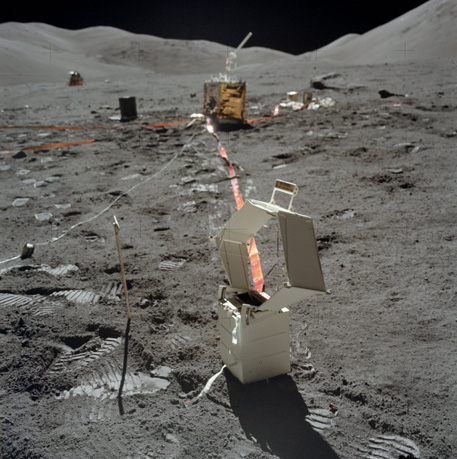
Documentation photo of the deployed LSG taken late in EVA-3.
The Central Station is in the background at center with the RTG to the left
and the LM in the distance beyond the RTG. Before taking this photo,
Jack Schmitt planted the tongs, temporarily, next to the LSG on the left.
NASA photo AS17-134-20501.
The Lunar Ejecta and Meteorites Experiment was
flown on Apollo 17 to study the frequency and nature of small particles
striking the Moon, and the effect of the ejecta they fling out. It
contained three sensor plates oriented in different directions,
allowing it to measure the velocity and direction of motion of
impacting particles. It was expected that this experiment would detect
both particles arriving from external sources, such as cometary debris
and interstellar grains, as well as particles ejected from the Moon by
other impacts. However, analysis of the results indicated that it
primarily detected fine lunar dust grains being transported at slow
speeds across the lunar surface at local sunrise.
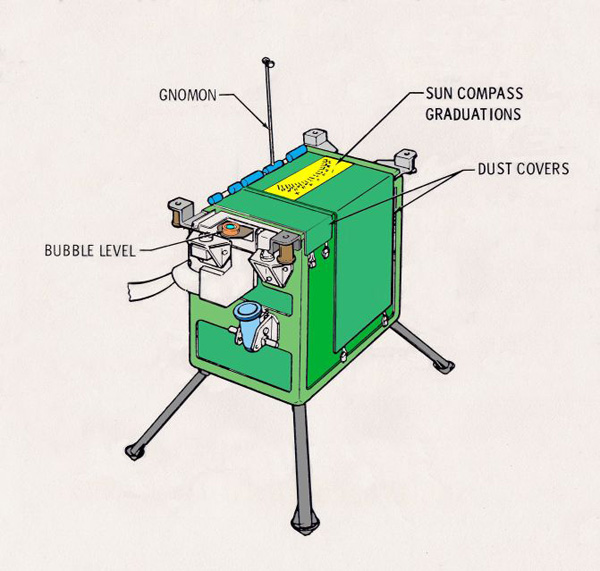
The Moon does have an atmosphere, but it is very tenuous. Gases in the lunar atmosphere are easily lost to space. Because of the Moon's low gravity, light atoms such as helium receive enough energy from solar heating so that they escape in just a few hours. Heavier atoms take longer to escape, but are ultimately ionised by the Sun's ultraviolet radiation, after which they are carried away from the Moon by the solar wind. This process takes a few months. Because of the rate at which atoms escape from the lunar atmosphere, there must be a continuous source of particles to maintain even a tenuous atmosphere. Sources for the lunar atmosphere include capture of particles from the solar wind and of material released from the impact of comets and meteorites. For some atoms, particularly helium-4 and argon-40, out-gassing from the Moon's interior may also be a source.
The Lunar Atmospheric Composition Experiment was
flown on Apollo 17. It was a mass spectrometer that measured the
composition of the lunar atmosphere. On earlier missions, only the
total abundance of the lunar atmosphere was measured by the Cold
Cathode Gauge. The three primary gases in the lunar atmosphere are
neon, helium, and hydrogen, in roughly equal amounts. Small amounts of
methane, carbon dioxide, ammonia, and water were also detected. In
addition, argon-40 was detected, and its abundance increased at times
of high seismic activity. Argon-40 is produced by the radioactive decay
of potassium-40 in the lunar interior, and the seismic activity may
have allowed escape of argon from the interior to the surface along
newly created fractures.
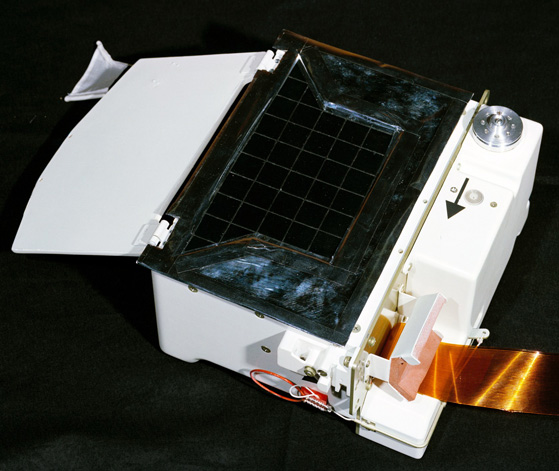
This experiment is similar in principle to the previous ALSEP
seismometers, but very different in design. It consists of a seismic
data gathering network of 4 geophones, placed in the center and at each
corner of a 90-meter equilateral triangle. Explosive charges on the
surface generated seismic waves of varying strengths to provide a
structural profile of the Apollo 17 site. The triangular arrangement of
the geophones allowed measurement of the azimuths and velocities of the
seismic waves more accurately than the Active Seismic Experiments on
Apollo 14 and 16.
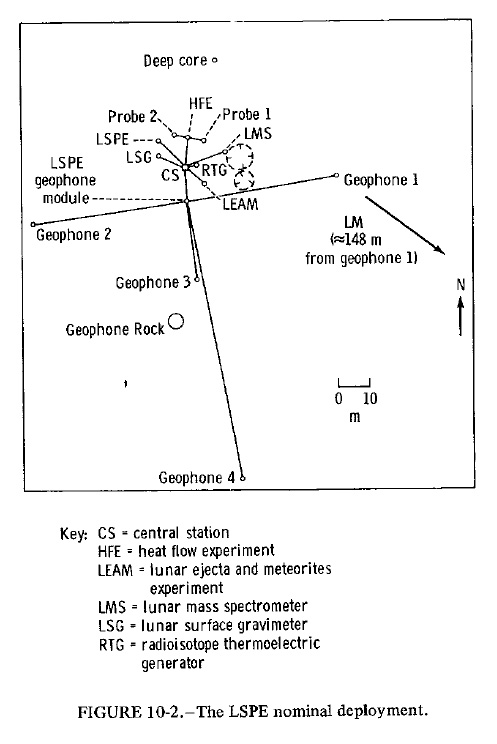
Figure 10-2 from the Apollo 17 OPreliminary Science Report shows the layout of the LSPE geophones and other elements of the ALSEP. Jack Schmitt picked a location for the Central Station that would satisfy various constraints for the other experiments and then modified the geophone layout to avoid the the 3-meter-tall boulder now known as Geophone Rock.
On Apollo 17, to profile the site terrain, eight explosive charges were positioned during the three EVAs to the specifications in the table below:
| Charge Wt. (kg) |
Charge No. |
Dist. from ALSEP (km) |
Detonation Time after LM Liftoff (hr:min) |
| 0.45 |
6 |
1.3 |
24:18 |
| 1.36 |
5 |
2.0 |
26:52 |
| 0.2268 |
7 |
0.8 |
28:08 |
| 0.0567 |
4 |
0.16 |
43:23 |
| 2.72 |
1 |
2.4 |
48:45 |
| 0.113 |
8 |
0.25 |
51:40 |
| 0.113 |
2 |
0.25 |
74:42 |
| 0.0567 |
3 |
0.16 |
75:46 |

A colored detail from Figure 10-7 from the Apollo 17 Preliminary Science Report
shows the locations where the charges were deployed.
The Solar Wind Composition Experiment (SWC) was
used to determine the
elemental and isotopic composition of the noble gasses (helium, neon,
and argon) in the solar wind. It was a simple experiment that used a
sheet of 0.5 mm thick aluminium foil to trap individual particles of
the solar wind to a depth of several hundred atomic layers, but allowed
cosmic rays to pass through. The astronauts put the screens out on
arrival and brought the foil back to Earth for analysis by Swiss
scientists.
In addition to the ALSEP’s LSM, a portable Magnetometer (LPM) was taken on Apollo 14 and 16. Its purpose was different. It was carried with the astronauts on the traverses and used to measure the Moon's magnetic field at several different spots. This technique of mapping differences in the magnetic field from place to place is a standard one on Earth and is used extensively in prospecting. Many ore bodies cause anomalies in the Earth's magnetic field. Thus, if at a particular place we expect the magnetic field to be 40,000 nT and it is 36,000 nT, then the anomaly is 4,000 nT. On the Earth, anomalies of several thousand nanoteslas are common. Not so on the Moon. The total magnetic field of the Earth is about 50,000 nT. Because the Moon's magnetic field is only about one-thousandth that of the Earth's field, the magnetic anomalies are much smaller. The range of the Portable Instrument is 256 nT.
An LPM was carried on the Apollo 14 mission. Unfortunately only two measurements were obtained then. Both were startling. The first, taken near the landing point (but out of the LM's magnetic field) was about 43 nT. The second was taken on Cone Crater. It was 103 nT. These values were startling for two reasons. First, they were much larger than expected beforehand. Previous satellite measurements had obtained an unequivocal indication that the average value for the magnetic field at the surface of the Moon could not be larger than 10 to 12 nT. Yet these values were much larger. The difference in the two values, 60 nT, was equally startling. Such large changes had not been expected to occur over a short distance. In order to help understand the rapid change with distance, several measurements were taken on Apollo 16. These changes with distance are almost surely caused by the natural magnetization of the lunar rocks.
Natural magnetization has been known in terrestrial rocks for many years. The term lodestone is the name used for a naturally occurring magnet. The material of lodestone is magnetite, a strongly magnetic mineral. There are, of course, other magnetic minerals but magnetite is the most common. It also occurs in lunar rocks.
The sensors were contained in a box mounted on a tripod. They were connected to an electronics box on the Rover by a 15.2 meter flat ribbon electrical cable. In use, the tripod was set about 15 meters from the Rover. It had to be oriented with the shadow of the Sun and levelled. The astronaut then returned to the Rover to read the instrument. There were three digital panel meters resembling digital clocks, one for each axis. These meters indicated the size of the three components of the Moon's magnetic field. The astronaut reported the readings over the voice communications link with Earth.
The tripod had to be erected a good distance from
the Rover because of the inherent magnetism of the vehicle and the
astronaut. So for the actual measurement, the sensors were set away
from both the astronaut and the Rover.
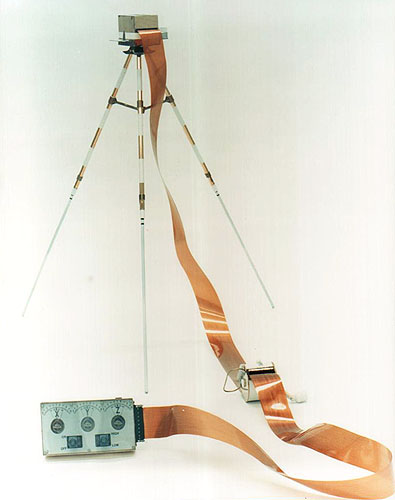
NASA photo S70-56721 shows the Apollo 14 LPM in a lab setting. The electronics box in the foreground included setting switches and three output dials and was attached to the Modular Equipment Transporter (MET or handcart). The sensor head was fitted onto the tripod, which was deployed 15 meters or so away from the MET during readings. A similar instrument was flown on Apollo 16, with the electronics box fitted to the back of the Lunar Roving Vehicle (LRV). NASA photo AS14-68-9393a shows the deployed Apollo 14 instrument. Ed Mitchell took this documentation photo while standing at the MET waiting for a measurement to finish.
This experiment was flown on Apollo 17
to measure variations of the gravitational acceleration resulting from
sub-surface structure at the Taurus-Littrow landing
site. Gravity measurements were made at 12 of the traverse stops on the
three EVAs, and the results were read back to Earth by the crew.
Interpretation of these observations also required knowledge of the
topography of the landing site, which was obtained from analysis of
stereo photography taken from lunar orbit. The results of this
experiment indicated that the mare basalt layer in the vicinity of the
landing site has a thickness of 1 kilometer. This value is slightly
less than the 1.4 kilometers measured by the Lunar Seismic Profiling
Experiment.
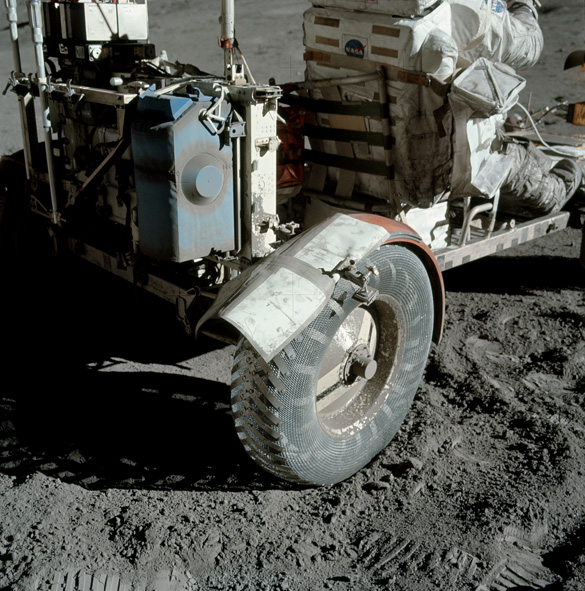
NASA photo AS17-137-20979 shows the blue Traverse Gravitmeter Experiment (TGE) mounted on the back of the Rover. Gene Cernan took this photo to document the replacement fender just before he and Jack Schmitt (already seated at the upper right) left Apollo 17 Station 2. At each geology station, Gene took the TGE off the back of the Rover, put it down on the surface well out of the way, got it to sit securely upright, and pushed a button to start a measurement. He could then do other work and, at a convenient time, pushed another button to display the result. NASA photo AS17-141-21600 shows Gene deploying the TGE on a steep slope at Station 6.
Cosmic rays are just particles that have extremely large energies and very high velocities. Their velocity is almost, but not quite, the speed of light. They are mostly protons and alpha particles (helium nuclei). But 1 to 2% of the cosmic rays consist of the nuclei of heavier elements. The cosmic rays seem to arrive from all directions and, although their origin is not yet known with certainty, they come from outside our solar system. In addition to cosmic rays, the CRD equipment detected low energy solar wind particles. The range of energy of the particles is very great, but some have very low energy. One purpose of the CRD experiment was to investigate the low-energy particles. Another purpose was to investigate neutrons from the lunar surface.
In the CRD experiment actual records of the
particles was obtained. The collector was a four panel array. Plate 1
was a sandwich of 31 sheets of 0.025 centimeters Lexan, covered by
perforated aluminiumised Teflon. Plate 2 was similar to Plate 1.
Plate 3 was four layers of 0.2 centimeter thick Kodacel cellulose
triacetate sheets, overlaid on the upper half by ten 5 micron thick
Lexan sheets. Plates of several special materials (some resemble
plexiglass) are carried on the outside of the Lunar Module to the Moon
and then brought back to Earth. The passage of particles through the
material is recorded in the form of tiny tracks. The characteristics of
these tracks, seen through a microscope, tell us the kind of particle
and, of course, its direction of travel. Some of the interest in this
experiment is due to the possibility that new elements could have been
discovered!
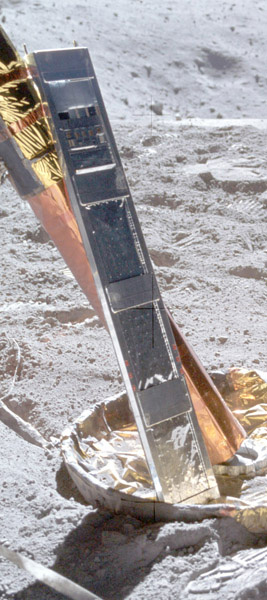
The lunar regolith, or the uppermost few meters of the Moon, consists of soil and highly fragmented rocks formed by repeated impacts of meteoroids with the Moon's surface. These impacts eject material from the craters that are formed, and the ejecta are usually deposited nearby. The overall effect of many such impacts is a continual overturn of the regolith, which keeps it well mixed. This can be thought of as a sort of gardening, analogous to the mixing of soil performed by a farmer's plough. The NPE was performed on Apollo 17 to determine the rate at which the lunar regolith is overturned or mixed. It consisted of a 2.4 meter long rod, with several detectors, that was inserted into the hole left from drilling a deep core sample. These detectors measured the number of neutrons penetrating to different depths in the regolith. The Neutron Probe was deployed on the first EVA and retrieved at the end of the third EVA after being exposed to the lunar regolith for 49 hours. It was then returned to Earth for analysis.
When cosmic-ray protons strike the lunar surface, nuclear reactions between the protons and atoms in the soil sometimes create neutrons, which may penetrate a short distance into the regolith. These neutrons are ultimately absorbed by other atoms, and the resulting nuclear reactions sometimes lead to the formation of radioactive isotopes, which later break down to form more stable isotopes. These radioactive isotopes provide a way to measure the rate at which the regolith is mixed. Because neutrons only penetrate a short distance into the regolith, finding radioactive elements at deeper depths means that material has been mixed to that depth in less time than it takes for the radioactive isotopes to break down. Measuring the regolith's mixing rate requires knowing three things: (1) the current abundance of radioactive elements, which is measured in core samples returned by the astronauts to Earth; (2) the rate at which radioactive elements decay, which is known from laboratory studies on Earth; and (3) the rate at which radioactive elements are created by neutron bombardment, which was determined from Lunar Neutron Probe data.
The degree of mixing in the regolith depends on the size of an impacting body, with larger impacts mixing material to greater depths. Small impacts are much more common than larger impacts, and so mixing to small depths occurs more often than mixing to large depths. Current estimates are that mixing to a depth of 1 centimeter occurs on average every million years, while mixing to a depth of 1 meter occurs only about once every billion years. These estimates are based on measurements of radioactive element abundances in lunar core tubes as well as on a variety of other chemical measurements of these cores.
This lunar neutron probe was designed to measure
the rates of low-energy neutron capture as a function of depth in the
lunar regolith. The experiment made use of two particle track detection
systems. A cellulose triacetate plastic detector was used in
conjunction with Boron 10 targets to record the alpha particles emitted
with the neutron capture on Boron 10. The second system used mica
detectors to detect the fission fragments from neutron-induced fission
in uranium 235 targets. The neutron probe had the form of a rod which
yielded an essentially continuous record of the neutron capture rate
from the lunar surface down to a depth of over 2 meters. The probe was
activated and deactivated by a rotational motion which brought the
target and detector system in and out of alignment. An on-off mechanism
was necessary to prevent accumulation of background events produced in
flight by neutrons from the ALSEP power generator and from cosmic ray
neutrons produced in the spacecraft. Point sources of uranium 238 were
included at three positions along the probe to provide fiducial marks
to verify that the probe was properly activated. In addition, cadmium
absorbers were included in the center and bottom of the probe to obtain
a neutron energy spectrum with a threshold of 0.35 eV. Further spectral
information was obtained from analyses of krypton 80 and krypton 82
produced by bromide neutron capture in potassium bromide contained in
evacuated capsules which were inserted at the top, middle, and bottom
of the probe. The experiment performed normally from activation
on December 12 1972 to termination at the end of the third EVA on
December 13 1972.
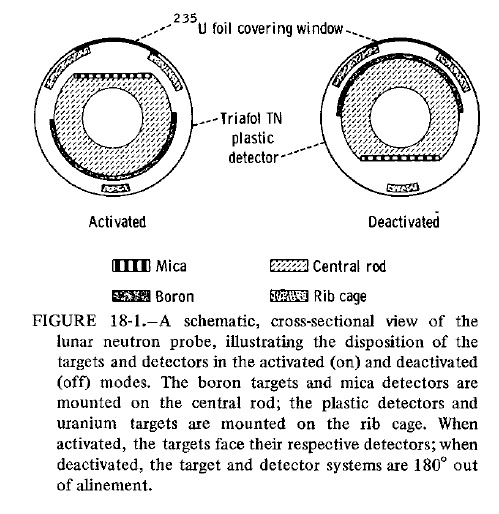
This experiment consisted of a transmitting antenna deployed near
the Lunar Module and a receiving antenna on the Rover. At several
different traverse stops, electrical signals were transmitted through
the regolith and recorded on the Rover. Comparison of the transmitted
and received signals allowed the electrical properties of the regolith
to be determined. This information was intended to provide "ground
truth" for the analysis of orbital observations by the Bistatic Radar
and Lunar Sounder Experiments. In addition, the results of this
experiment showed that the upper 2 kilometers of the lunar surface are
extremely dry, which is consistent with measurements of lunar rock
composition.
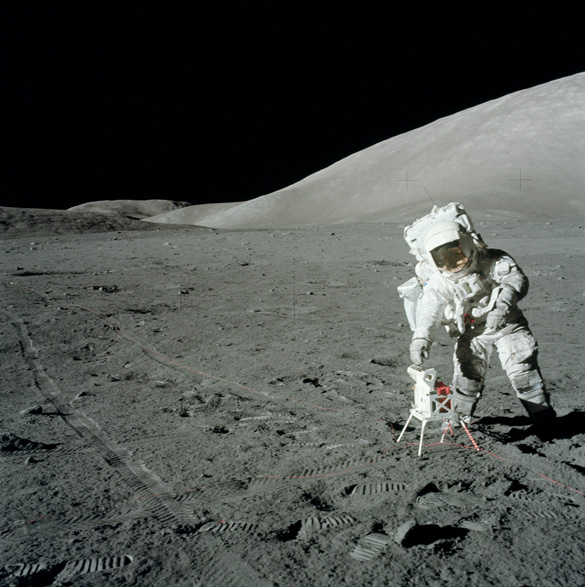
NASA photo AS17-134-20438 shows Jack Schmitt as he reaches down to open a three-segment solar array that powers the SEP transmitter. The transmitter is located at the intersection of a cross of Rover tracks that Gene layed out prior to the deployment. The antenna wires runing off to the south (upper left), east (lower left, and south (lower right) can be seen in the image. This frame is part of a partial panorama (assembled by David Nathan) that Gene took of the deployment. The panorama shows more of the antenna layout. NASA photo AS17-141-21511 shows the transmitter as deployed, including pieces of duct tape used by the crew to keep the solar array open.
The purpose of the SEP experiment was to obtain data about the electromagnetic energy transmission, absorption, and reflection characteristics of the lunar surface and subsurface for use in the development of a geological model of the upper layers of the moon. This experiment determined layering, searched for pressure of water below the surface, and measured electrical properties in situ, determining these as a function of depth. The selected frequency range was chosen to measure these properties in a range from a few meters to a few kilometers depth. The transmitter produced continuous waves at 1, 2.4, 4, 8.1, 16, and 32.1 MHz, successively. These waves permitted measurement of the size and number of scattered bodies in the subsurface. Any moisture present was easily detected because minute amounts of water in rocks or subsoil change the electrical conductivity by several orders of magnitude. The equipment for this experiment consisted of a deployable self-contained transmitter, a multiple frequency transmitter antenna, a portable receiver/recorder on the Rover, a wide-bandwidth mutually orthogonal receiver antenna, and a retrievable data recording device. The crew transported and set up the transmitter approximately 100 meters from the Lunar Module and then deployed the antennas. The receiver/recorder was placed on the Lunar Rover. The crew established the location of the Rover in relation to the transmitter for each data stop during the traverse. Wheel turns were counted for distance, and differences between wheel turns on the right and left sides of the vehicle were used to compute azimuth. The recorder was then returned to Earth.
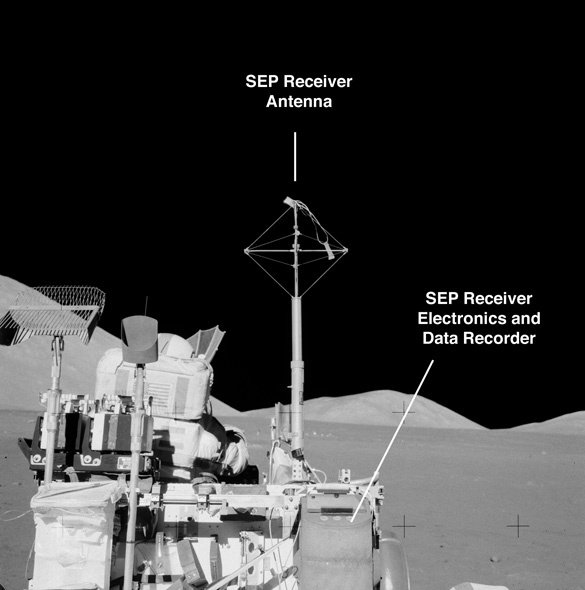
NASA photo AS17-135-20543 shows the components of the SEP Receiver mounted behind the LMP's Rover seat. The electronics and data recorder are stowed in a bag designed to provide thermal protection. Failure of adhesive on the back of Velcro patches that held the bag cover closed led to overheating, which significantly limited the amount of useful data collected.
........................................................................
Downlink Frequency : 2278.5 MHz.
The central station, located 90 meters North West of the LM at 3.00942 S Latitude 23.42458 W longitude, was turned on at 1421 UT on November 19 1969 and off on September 30 1977. Additional experiment, not part of ALSEP:
Downlink Frequency : 2279.5 MHz.
The central station, located 180 meters West of the LM at 3.64398 S latitude, 17.47748 W longitude, was turned on at 1723 UT on February 5 1971 and failed during January 1976.
Additional experiments, not part of ALSEP,
were:
Downlink Frequency : 2278.0 MHz
The central station, located 125 meters North West of the LM at 26.13407 N latitude, 3.62981 E longitude, was turned on at 1837 UT on July 31 1971 and shut down on September 30 1977.
Additional experiments, not part of ALSEP, were:
Downlink Frequency : 2276.0 MHz.
The central station, located 100 meters West South West of the Lunar Module at 8.97537 S latitude, 15.49812 E longitude, was turned on at 1938 UT on April 211972 and shut down along with the other ALSEP stations on September 30 1977.
Additional experiments, not part of ALSEP, were:
Downlink Frequency : 2275.5 MHz
The central station, located 185 meters West North West of the LM at 20.19209 N latitude, 30.76492 E longitude, was turned on at 0253 UT on December 12 1972 and shut down along with the other ALSEP stations on September 30 1977.
On March 15 1973 a Post-Apollo Lunar Programs Office, under which the Lunar Data Analysis and Synthesis Program would be conducted, was established within the Office of Space Science at NASA Headquarters. The office was responsible for continued operation and collection of data from the ALSEP and the P&F sub-satellites; Apollo surface and orbital science data analysis by principal investigators; development of selenodetic, cartographic, and photographic products; continued lunar laser ranging experiment; continued lunar sample analysis; lunar supporting research and technology; and advanced program studies.
When funding for the technical and scientific support ran out, all five ALSEP stations were officially shut down on September 30 1977, after more than 153,000 commands were transmitted to them, and more than one trillion bits of science data were received on Earth. Although the experiments were turned off, the transmitters continued to send carrier signals which were used by various institutions, including the Jet Propulsion Laboratory, for geodetic and astrometric studies, and spacecraft navigation.
After four years of sending a steady flow of data, the Apollo 14 ALSEP developed an intermittent fault. It began an intermittent ‘on’ and ‘off’ cycle for its last two years, due to a short circuit in one of the power conditioning units. It seemed related to the temperature of the unit, reacting to the position of the Sun over the site.
The ALSEP program cost NASA an estimated $US200
million, including the design and development of the stations and
experiments, support engineering work in Houston, and the analysis of
the data by dozens of University laboratories around the world. It cost
NASA $US2 million a year to operate.
[Developed by the staff of the Curator for Planetary Materials Office at the Johnson Space Center. The Curator is responsible for the curation of both lunar samples and meteorites and distributes these items for scientific study.]
1. The Moon is not a primordial object; it is an evolved terrestrial planet with internal zoning similar to that of Earth.
Before Apollo, the state of the Moon was a subject of almost unlimited speculation. We now know that the Moon is made of rocky material that has been variously melted, erupted through volcanoes, and crushed by meteorite impacts. The Moon possesses a thick crust of 50 kilometers, a fairly uniform lithosphere (60-1000 kilometers), and a partly liquid asthenosphere (1000-1740 kilometers); a small iron core at the bottom of the asthenosphere is possible but unconfirmed. Some rocks give hints for ancient magnetic fields although no planetary field exists today.
2. The Moon is ancient and still preserves an early history (the first billion years) that must be common to all terrestrial planets.
The extensive record of meteorite craters on the Moon, when calibrated using absolute ages of rock samples, provides a key for unravelling time scales for the geologic evolution of Mercury, Venus, and Mars based on their individual crater records. Photogeologic interpretation of other planets is based largely on lessons learned from the Moon. Before Apollo, however, the origin of lunar impact craters was not fully understood and the origin of similar craters on Earth was highly debated.
3. The youngest Moon rocks are virtually as old as the oldest Earth rocks. The earliest processes and events that probably affected both planetary bodies can now only be found on the Moon.
Moon rock ages range from about 3.2 billion years in the maria (dark, low basins) to nearly 4.6 billion years in the terrae (light, rugged highlands). Active geologic forces, including plate tectonics and erosion, continuously repave the oldest surfaces on Earth whereas old surfaces persist with little disturbance on the Moon.
4. The Moon and Earth are genetically related and formed from different proportions of a common reservoir of materials.
The distinctively similar oxygen isotopic compositions of Moon rocks and Earth rocks clearly show common ancestry. Relative to Earth, however, the Moon was highly depleted in iron and in volatile elements that are needed to form atmospheric gases and water.
5. The Moon is lifeless; it contains no living organisms, fossils, or native organic compounds.
Extensive testing revealed no evidence for life, past or present, among the lunar samples. Even non-biological organic compounds are amazingly absent; traces can be attributed to contamination by meteorites.
6. All Moon rocks originated through high-temperature processes with little or no involvement with water. They are roughly divisible into three types: basalts, anorthosites, and breccias.
Basalts are dark lava rocks that fill mare basins; they generally resemble, but are much older than, lavas that comprise the oceanic crust of Earth. Anorthosites are light rocks that form the ancient highlands; they generally resemble, but are much older than, the most ancient rocks on Earth. Breccia are composite rocks formed from all other rock types through crushing, mixing, and sintering during meteorite impacts. The Moon has no sandstones, shales, or limestones such as those that testify to the importance of water-borne processes on Earth.
7. Early in its history, the Moon was melted to great depths to form a "magma ocean." The lunar highlands contain the remnants of early, low-density rocks that floated to the surface of the magma ocean.
The lunar highlands were formed about 4.4-4.6 billion years ago by flotation of an early, feldspar-rich crust on a magma ocean that covered the Moon to a depth of many tens of kilometers or more. Innumerable meteorite impacts through geologic time reduced much of the ancient crust to arcuate mountain ranges between basins.
8. The lunar magma ocean was followed by a series of huge asteroid impacts that created basins that were later filled by lava flows.
The large, dark basins such as Mare Imbrium are gigantic impact craters, formed early in lunar history, that were later filled by lava flows about 3.2-3.9 billion years ago. Lunar volcanism occurred mostly as lava floods that spread horizontally; volcanic fire fountains produced deposits of orange and emerald-green glass beads.
9. The Moon is slightly asymmetrical in bulk form, possibly as a consequence of its evolution under Earth's gravitational influence. Its crust is thicker on the far side, while most volcanic basins -- and unusual mass concentrations -- occur on the nearside.
Mass is not distributed uniformly inside the Moon. The large mass concentrations ("Mascons") that lie beneath the surface of many large lunar basins are due mainly to mantle uplift under the basins caused by rebound following the impact, together with some lava fill. Relative to its geometric center, the Moon's center of mass is displaced toward Earth by several kilometers.
10. The surface of the Moon is covered by a rubble pile of rock fragments and dust, called the lunar regolith, that contains a unique radiation history of the Sun that is of importance to understanding climate changes on Earth.
The regolith was produced by innumerable meteorite impacts through geologic time. Surface rocks and mineral grains are distinctively enriched in chemical elements and isotopes implanted by solar radiation. As such, the Moon has recorded four billion years of the Sun's history to a degree of completeness that we are unlikely to find elsewhere.